
The Genesis Nomad, also known as Sega Nomad, is a handheld game console manufactured by Sega and released in North America in October 1995. The Nomad is a portable variation of the Sega Genesis home video game console. It could also be used with a television set via a video port. It was based on the Mega Jet, a portable version of the home console designed for use on airline flights in Japan.
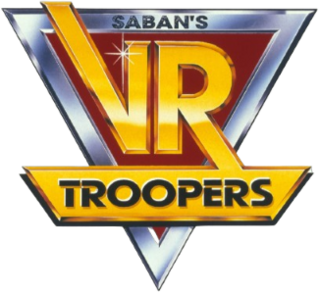
VR Troopers is a syndicated live-action superhero-adventure television series produced and distributed by Saban Entertainment from 1994 to 1996. The show tried to profit from the fascination with virtual reality in the mid-1990s as well as the success of Saban's other property, Power Rangers. VR Troopers was the first official "sister series" to Mighty Morphin Power Rangers. Much like it, this was an Americanization of a Japanese tokusatsu children's program series by Toei Company. The series is a co-production of Toei and Cyberprod.
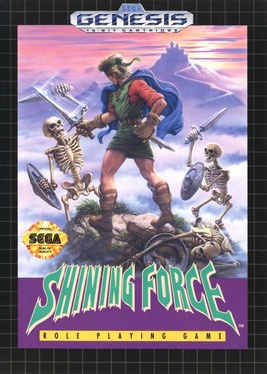
Shining Force is a 1992 turn-based tactical role-playing game for the Sega Genesis console. It is the second entry of the Shining series of video games, following Shining in the Darkness. While primarily a traditional fantasy-themed game, it contains some science fiction elements.

Dr. Robotnik's Mean Bean Machine is a falling block puzzle game developed by Compile and published by Sega. It was released for the Sega Genesis / Mega Drive in North America and Europe in November 1993, and ported to the Game Gear in 1993 and Master System in 1994.

Super Street Fighter II: The New Challengers is a 1993 competitive fighting game produced by Capcom and originally released as an arcade game. It is the fourth game in the Street Fighter II sub-series of Street Fighter games, following Street Fighter II: Hyper Fighting (1992). It refines and balances the existing character roster from the previous versions, and introduces four new characters, including Cammy and Dee Jay. It is the first game on Capcom's CP System II hardware, with more sophisticated graphics and audio over the original CP System hardware used in previous versions of Street Fighter II.

Streets of Rage 2, known as Bare Knuckle II in Japan, is a 1992 beat 'em up game developed and published by Sega for the Genesis/Mega Drive. A sequel to Streets of Rage (1991), the characters Axel Stone and Blaze Fielding return while the game also introduces two new characters: Max Thunder, and Eddie "Skate" Hunter, the younger brother of Adam Hunter from the first game.

Galaxy Fight: Universal Warriors is a 1995 fighting game produced by Sunsoft on the Neo Geo hardware. It was Sunsoft's second fighting game after their 1994 Super Famicom game, Sugoi Hebereke, as well as their first side-viewed 2D fighting game. The MVS arcade version of Galaxy Fight uses 32 four-megabit ROM chips.
Cyber Troopers Virtual-On is a series of video games developed by Sega AM3/Hitmaker, and originally created by Juro Watari. The games feature fast, action-oriented gameplay requiring quick reflexes, featuring mecha called Virtuaroids or "VRs", that are large robots the player controls in battles against enemy VRs. The first game was Virtual On: Cyber Troopers (1995), which was released globally, while its following four installments in the series were mainly Japan exclusives where the series has retained high popularity.

King of the Monsters is a fighting game developed by SNK, released for arcades in Japan in 1991, and ported to the Neo Geo AES later that same year. The game features playable giant monsters that are reminiscent of characters from kaiju and tokusatsu films.
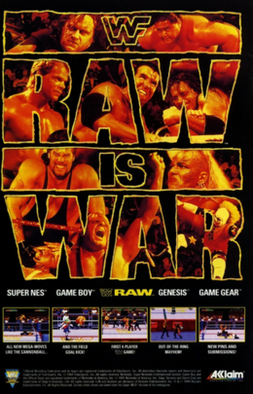
WWF Raw is a professional wrestling video game based on the television show of the same name produced by the World Wrestling Federation (WWF), released for the SNES, 32X, Mega Drive/Genesis, and Game Boy in late 1994 and early 1995 by Acclaim Entertainment. It is the sequel to the WWF Royal Rumble game that was released in 1993, and is the final part of LJN's 16-bit WWF trilogy. Players can play either One-on-One, Tag Team, Bedlam, Survivor Series, Royal Rumble, or a Raw Endurance Match. Unlike its predecessor, WWF RAW is multitap compatible.

Mighty Morphin Power Rangers is the title of five different video games based on the first season of the television series of the same name, one for each of the following game platforms: Sega Genesis/Mega Drive, Super Nintendo Entertainment System, Game Boy, Game Gear, and Sega CD. The Nintendo versions of the game were released by Bandai, while the Sega versions were published by Sega itself and the production of the cartridge versions was carried by Banpresto, a pseudonym of Bandai. The Green Ranger is only playable on the Genesis and Game Gear versions of the game.

Dragon: The Bruce Lee Story is a fighting video game developed and originally published by Virgin Interactive Entertainment in Europe for the Sega Genesis in June 1994. It is based on the 1993 film of the same name, which is a semi-fictionalized account of the life of Hong Kong-American actor and martial artist Bruce Lee. Following the events of the movie, players take control of Bruce Lee across several stages that takes places in different time periods of his life and fight against some of his adversaries.

Mighty Morphin Power Rangers: The Movie is the title of four different video game adaptations of the film of the same name which were released for the Super NES, Genesis, Game Boy, and Game Gear. While the games are ostensibly based on the film, they also feature characters and plot elements from the second season of the original TV series. Like the previous game versions of the original Mighty Morphin Power Rangers, none of the four versions of the movie game are ports of each other.

Double Dragon V: The Shadow Falls is a fighting game developed by Leland Interactive Media and published by Tradewest for the Super Nintendo Entertainment System and Sega Genesis in 1994. A port for the Atari Jaguar developed by Telegames was released the following year. It is an American-produced sequel to the Double Dragon series by Technōs Japan, who had little to no credited involvement in the development of the game outside of licensing the IP to the publisher outside Japan.
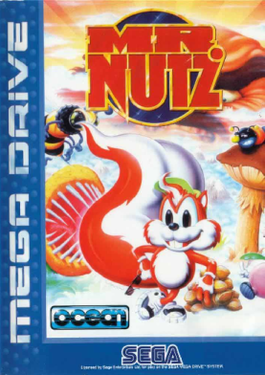
Mr. Nutz is a 2D side-scrolling platform game published by Ocean Software. It was released for the Super Nintendo Entertainment System in late 1993 in Europe and in North America and Japan in 1994. In 1994, it was released for the Mega Drive as Ocean's first Sega game, and on the Game Boy. It was also released on the Sega Channel in 1995, the Game Boy Color in 1999, and remade for the Game Boy Advance in 2001.
Puyo Puyo (ぷよぷよ), previously known as Puyo Pop outside Japan, is a series of tile-matching video games created by Compile. Sega has owned the franchise since 1998, with games after 2001 being developed by Sonic Team. Puyo Puyo was created as a spin-off franchise to Madō Monogatari, a series of first-person dungeon crawler role-playing games by Compile from which the Puyo Puyo characters originated. The series has sold over 10 million copies, including the Madō Monogatari games.
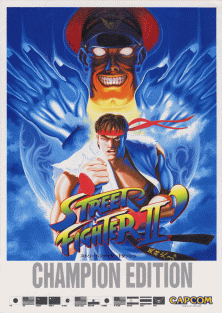
Street Fighter II: Champion Edition, released as Street Fighter II Dash in Japan, is a fighting game released by Capcom in 1992. It was launched for arcades and converted to several video game consoles. It is the first of several updated versions of Street Fighter II, and part of the Street Fighter series. The main changes are the addition of the four grand masters as playable characters and mirror matches. The fighting techniques of the eight main characters from the original game were further balanced for competitive play.
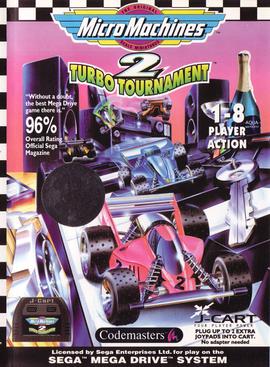
Micro Machines 2: Turbo Tournament is a 1994 racing video game developed by Supersonic Software and published by Codemasters for the Sega Mega Drive. The sequel to Micro Machines, the game is themed around Galoob's Micro Machines toys, and players race around environments in miniature toy vehicles. Micro Machines 2: Turbo Tournament adds new vehicles and game modes, and the Mega Drive version was released on J-Cart, enabling up to eight players without a multitap.
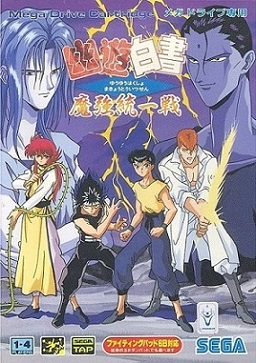
Yu Yu Hakusho Makyō Tōitsusen is a 1994 fighting game developed by Treasure and published by Sega for the Mega Drive. It is based on the manga series Yu Yu Hakusho by Yoshihiro Togashi. The plot follows the protagonist Yusuke Urameshi, who is tasked by the ruler of the afterlife with solving detective-style cases involving both humans and demons threatening the living world. The story begins to focus heavily on martial arts battles as it progresses.

Dragon Ball Z: Idainaru Son Goku Densetsu is a 1994 fighting video game developed by BEC and published by Bandai for the PC Engine Super CD-ROM² add-on. Based upon Akira Toriyama's Dragon Ball franchise, it is a retelling of Goku's seven major battles over the course of the series up to the conclusion of the Cell Games saga. Idainaru Son Goku Densetsu was created by most of the same team at BEC that would go on to work on Dragon Ball Z: Idainaru Dragon Ball Densetsu. The game received generally positive reception from critics who reviewed it as an import title but criticism was geared towards its difficulty level.

















